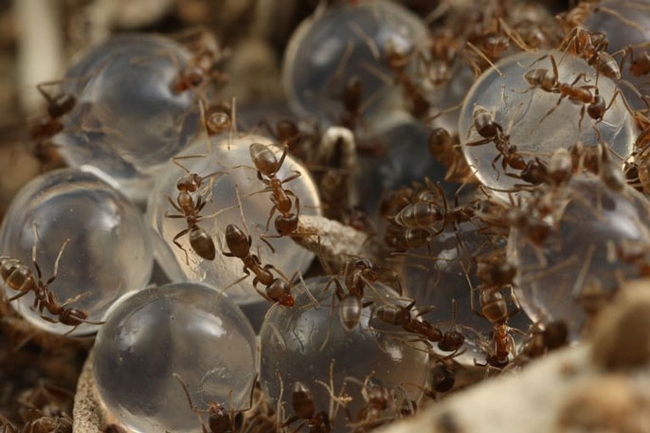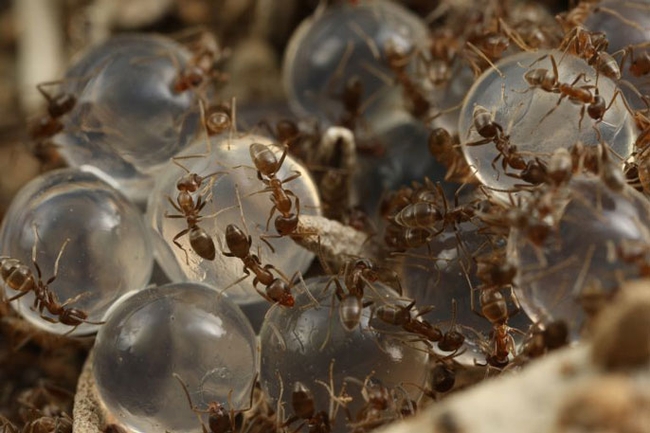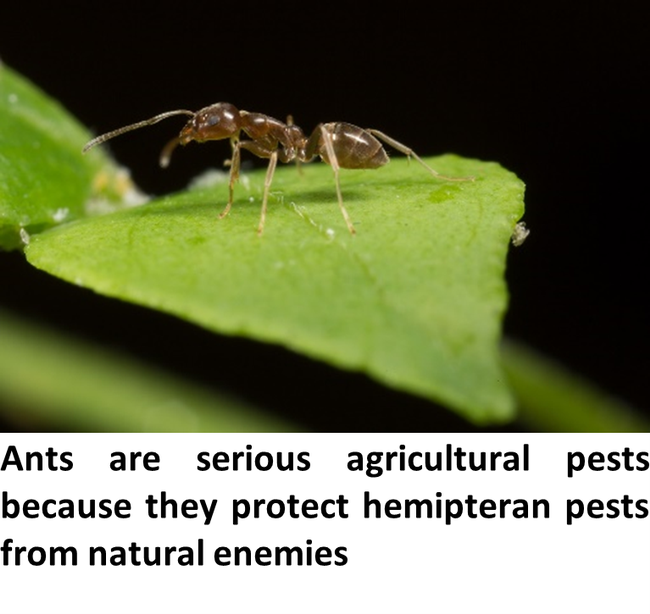
Posts Tagged: ants
Ants and Mealybugs?
Managing citrus mealybug – does ant control help?
Sandipa Gautam, Sanjeev Dhungana, and David Haviland
UC Co-operative Extension
Starting 2019/20 season, pest control advisors started noticing citrus mealybug infestations in multiple citrus varieties that continued to increase in acreage in the San Joaquin Valley. Although present in the citrus systems, mealybugs were considered to be a minor pest and kept well under check by natural enemies until recently.
What are mealybugs?
Mealybugs are soft, oval, flat, distinctly segmented insects whose body is covered in white mealy wax. Citrus mealybug, Planococcus citri is the most common species associated with citrus. Females lay ~600 eggs in egg sacs loosely held by white cottony flint. Crawlers are yellowish, and can move or be carried by ants, birds, or the wind to start new infestations. Crawlers feed by sucking sap using straw-like stylets and soon develop a waxy covering (Fig. 1C). Like California red scale, females molt and stay as third instars until mated by a male. Males go through a pupal stage and emerge as adults with wings that fly to seek a mate.
Mealybugs prefer the inside canopy of the tree and can be found under dense leaves, between clusters of fruits, or in other cryptic places where they can be difficult to find, especially when the population is low. As the season progresses and the tree flushes, blooms, and fruit develops, mealybugs move to the parts of the tree where nutrients flow. Ongoing research on seasonal phenology suggest that there are 5-6 generations in the San Joaquin Valley. The first generation starts from overwintering adult/egg populations in late March/early April. The second-generation crawlers/nymphs move to fruit in June/July. The remaining generations each year primarily feed and multiply on the fruit.
Mealybugs produce nutrient rich honeydew that is an attractive food source for ants. Ants have been reported to defend insect colonies from predators and parasitoids. In an early infestation, ant trails can be used as an indicator to locate mealybug infestations or other sap sucking pests. Managing sugar feeding ants in citrus orchards has shown increased biocontrol of sap sucking insects. It is plausible that loss of chlorpyrifos as an ant control tool may have aggravated ants thereby aiding to increase mealybug pressure in recent years.
As mealybugs have become a reoccurring pest in citrus orchards, University of California researchers-initiated studies to work towards developing strategies to manage this pest. Research funded by Citrus Research Board and led by Gautam lab is investigating biology, field ecology, and management of mealybugs. During field visits, our observations have shown that various ant species of were present throughout the growing season attending mealybug colonies.
Does managing ant help suppress mealybug?
UC researchers have documented that managing sugar feeding ants increases biocontrol, thereby reducing the pest pressure of sap sucking insects. When ant densities are were reduced >90%, there was ~90% less mealybug on twigs and complete elimination of mealybug was reported from fruit. However, managing ants has been a challenge since the use of chlorpyrifos was banned. To address this need, UC researchers have worked to develop and test different types of hydrogel beads for delivering insecticide products to sugar-feeding species of ants.
Research led by David Haviland has focused on the experimental use of commercially-available polyacrylamide hydrogel beads for large field-scale applications. In 2023 a large-scale field trial was conducted in a 20-acre grapefruit block in Sanger, California. Two applications of hydrogel beads laced with insecticides were made on Aug 2 and August 30, 2023. Post-treatment evaluations for ant density were done on 24 trees/plot by counting the number of ants that passed through a graft union for 15 secs weekly for 4 weeks after each application. The effects of ant suppression on mealybug densities was evaluated in October 2023 by counting the number of fruits infested with mealybugs (presence/absence) on 30 fruits from the inside canopy. Insecticide treatments had variable results on ant density, with lowest ant density consistently found in plots treated with thiamethoxam. Similarly, plots treated with thiamethoxam had the lowest populations of mealybugs.
There's a lot more to this story:
https://ceventura.ucanr.edu/Com_Ag/Subtropical/?newsletteritem=100493

mealybug stages
Ants Come Marching In - UC IPM Citrus Update
UC IPM supports research and extension programs in integrated pest management (IPM). UC Agriculture and Natural Resources scientists adapt research for practical application, and Cooperative Extension advisors and specialists develop and deliver IPM programs to a variety of clientele, including professional pest managers, growers, residents, and agencies. UC IPM staff work with UC ANR scientists to develop "how-to" materials that help the clientele carry out programs and solve pest problems.
To complement the extension programs, UC IPM staff members coordinate development of a variety of materials that explain how to carry out pest management tactics and strategies. Working with UC ANR experts, program staff produce and maintain an extensive array of print and Web-based publications, databases, training materials, and interactive tools for decision making.
Examples are the pest management guidelines and a home and landscape database of pest solutions for residential audiences, IPM manuals for specific crops, books about IPM in landscapes and gardens, a variety of books on pesticide safety, and an extensive weather database that supports interactive pest models.
And now they are happy to announce the publication of a new update to the Citrus PMG. The Year-Round Program has been updated, Ants, Asian Citrus Psyllid, and Huanglongbing
And to learn more about Ant control in citrus, cherimoya and passion fruit, look into the upcoming workshops, September 19 and 21:
https://ucanr.edu/blogs/blogcore/postdetail.cfm?postnum=57442
https://ucanr.edu/blogs/blogcore/postdetail.cfm?postnum=57622

argentine ant and hydrogels
Ants and the Pests They Support Workshop
Are you interested in learning about the management of sap-sucking pests and ants in citrus orchards? Lindcove is organizing a full-day workshop to bring you recent research advances on sap-sucking insects and ant management. The workshop will focus on ants.
Ants, especially the invasive Argentine ant and the native grey field ant, are serious pests because they protect sap-sucking pests infesting citrus, grapes, and other perennial tree and vine crops, from their natural enemies. In return for protection, hemipteran pests like Asian citrus psyllid mealybugs, soft scales, aphids, and whiteflies reward ants with honeydew, a sticky sugar-rich waste product that ants imbibe and return to nests to feed nest mates. This is an example of food-for-protection mutualism that is highly disruptive to biological control and IPM programs. This workshop will cover the latest developments in ant monitoring and management and will provide overviews of the benefits of ant control and how reductions in ant densities result in very high levels of biological control of important hemipteran pests.
When: 19 September 2023
Where: Conference room, Lindcove Research and Extension Center, 22963 Carson Ave, Exeter, CA 93221
Meeting Registration Link: https://surveys.ucanr.edu/survey.cfm?surveynumber=41086
Workshop Agenda:
|
Time |
Presenter |
Topic |
|
8:30am |
|
Registration |
|
9:00am |
Mark Hoddle, UC Riverside |
Overview of the Asian citrus psyllid biological control program and the need to control pest ants |
|
9:30am |
Mark Hoddle, UC Riverside |
Use of biodegradable hydrogel beads and bait stations for controlling pest ants in citrus |
|
10:00am |
Mike Lewis, UC Riverside |
Infrared sensors and the Internet of Things to automate ant counts in orchards |
|
10:30am |
|
Coffee Break |
|
10:45am |
David Haviland, UCCE Farm Advisor, Kern County |
Ant management research and applications in the San Joaquin Valley |
|
11:15am |
Soon Il Kwon, UC Riverside |
Cultural control of ants in orchards |
|
11:45am |
Nicola Irvin, UC Riverside |
Flowering cover crops to promote natural enemy ecosystem services |
|
12:15pm |
|
Lunch |
|
1:00pm |
Sandipa Gautam, UCCE Area Citrus IPM Advisor |
Hemipteran pests and their management in SJV citrus |
|
1:30pm |
All presenters |
Table visits and posters to observe technologies that were discussed and to interact with presenters and ask questions |
|
2:00pm |
David Haviland/Hoddle Lab |
Field demonstration of hydrogel applications for ant control |
|
3:00m |
|
Workshop Ends |

argentine ant and hydrogels
The End of ACP and Argentine Ant?
Argentine Ant is the great protector of many pests found on plants. Without the Argentine, many pests would not be so much of a problem. In many crops, like cherimoya and passionfruit, mealy bug can become so severe that fruit will stop growing and fall off the tree. Controlling Argentine, makes it possible for predators and parasites to do their thing in bringing them under control. Watch these two videos to see how hoverflies (syrphids) can help biocontrol and how Argentine Ant control can help that biocontrol
Citrus Psyllids Bribe Ants With Strings Of Candy Poop | Deep Look - YouTube
How Hoverflies Spawn Maggots that Sweeten Your Oranges | Deep Look - YouTube
Cherimoya fruit and stems covered with mealy bug.

cherimoya mealy bug
Starving Argentine Ants
It might seem like common sense that a starving animal is more likely to take dangerous risks to obtain food than one with a full belly. But new research from UCLA shows that groups of Argentine ants, who forage boldly when they're well fed, exercise far more caution when they've been deprived of carbohydrates and the risks from competitors are high.
This counterintuitive foraging strategy might contribute to the success of these insects, known as Linepithema humile, an invasive species that displaces native ant populations in California and elsewhere and has become a significant agricultural pest, the researchers said.
Their findings, published in the journal Current Zoology, suggest that the unwillingness of Argentine ants to expose themselves to danger when weakened by hunger could possibly give them a competitive edge over other species by helping to preserve their colonies' foraging capabilities.
“While not foraging may lead to a reduction in food stores when those stores are already low, foraging in a high-risk environment exposes the colony to potential loss of foragers,” said the study's senior author, Noa Pinter-Wollman, a UCLA professor of ecology and evolutionary biology. “So reduced foraging could be interpreted as individual foragers not taking unnecessary risks.”
To support the energetic requirements of daily life, all ants require carbohydrates, which they obtain from a variety of plant and animal sources. They also need protein, which they generally get from dead animals, to nourish their larval offspring. Ant colonies adjust their foraging strategies according to the availability of these food sources, the presence of competing ant species, and the threat of predators or other dangers. Well-fed ants will forage for carbohydrates even in the presence of other ant species or danger cues.
First author Bryce Barbee, who conducted the research as a UCLA undergraduate, expected that starving Argentine ants of either carbohydrates or protein would only increase their willingness to forage for those foods in high-risk environments because they had little to lose and everything to gain.
Together with Pinter-Wollman, Barbee designed a series of laboratory experiments that involved feeding ants normally, depriving them of either carbohydrates or protein, and depriving them of both, then allowing them to forage as they normally would in either low-risk or high-risk environments.
The researchers created the impression of high-risk environments with formic acid, a chemical marker produced by ants, to signal the presence of competitors.
When the risk was low, starving ants did indeed forage more vigorously for the food of which they had been deprived. But when the risk was high, starving ants surprised the researchers by becoming more cautious, not less, in their foraging strategies.
In both high- and low-risk foraging scenarios, the ants were more willing to forage for carbohydrates than protein, which they only need to raise their brood. Since no eggs or pupae were present in the laboratory colonies, this finding might not be surprising, but it could also indicate that starving ants put their own energetic needs ahead of raising offspring, the researchers said.
Scientists who study animal behavior have advanced two ideas to explain foraging strategies. The first, known as the asset-protection principle, holds that hungry animals have less to lose than satiated animals and will therefore behave more assertively to get food. The second, the state-dependent safety hypothesis, holds that animals in good condition are more likely to take risks because they are more likely to survive dangers they encounter.
“Our work upheld the state-dependent safety hypothesis but not the asset-protection principle,” said Barbee, now a doctoral student at UC Santa Barbara. “The findings suggest that factors such as activity level and energetic costs of starvation are important for Argentine ant foraging decisions.”
The work points toward an avenue of research that could lead to better efforts to control the spread of Argentine ants and mitigate their detrimental impact on agriculture, the researchers said.
https://academic.oup.com/cz/advance-article/doi/10.1093/cz/zoac089/6825390
Ant species across five subfamilies exchange milk-like substances. Jasius via Getty Images

ants feeding

